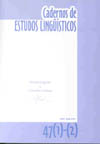Resumo
The present work interprets verbal inflection error’s in M’s speech from 1;0.23 to 3;04.30, according to the theorization developed by De Lemos (1982 to 2002). Both regular and irregular verbs are foccused. Two works about portuguese verbal inflection acquisition were remembered: Figueira (1998, 2003) and Perroni-Simões (1976). The last one observed the prevalence of the first conjugation in the child’s errors. She proposed an order for the acquisition of verbal inflection by the children. However, responding just about the prevalence of one of the conjugation classes was to treat the question partially, because language acquisition is a subjectivity process, in which subject and language form an unity. The changes (linguistic and subjective ones) that occur in language acquisiton process are changes of position in a structure, where are present: the other, the language, and the subject him/herself. The outline analysis is offered by theorical model. It is verified in M’s speech that divergent verbal forms came from the speech of the other towards her, what is interpreted as the first position of the child in the structure, marked by the dominance of the child’s speech alienation to the other’s speech. In the second position, caracterized by the dominance of language movement in the child’s speech, errors were also founded in M’s speech. It was observed the movement of linguistics chains, that in a parallelistic game, has given support to changes in the child’s speech. The child’s displacement in the structure, from the first to the second position, is foccused. Verbal inflection error’s have given the investigator the privilege of seeing in the child’s speech the exact point of conversion of the speech of the other into his/her own speech (or in the subject’s speech), as indicated by the theorization developed by De Lemos (1982 to 2002).Referências
BYBEE, L. J. & SLOBIN, D. (1982). Rules and Schemas in the development and use of the english past tense. Language. Journal of the linguistic society of America. v. 2, n. 2.
CÂMARA JR., J.M. (1982). Estrutura da língua portuguesa. 2ª ed. Petrópolis: Ed. Vozes, pp. 104-110.
CUNHA, C.F. (1972). Gramática da Língua Portuguesa. 3ª ed. Fename.
DE LEMOS, C.T.G. (2002a). Sobre o estatuto lingüístico e discursivo da narrativa na fala da criança. Texto Inédito.
DE LEMOS, C.T.G. (2002b). Das vicissitudes da fala da criança e de sua investigação. In: ORLANDI, E. (org.) Cadernos de Estudos Lingüísticos. História das idéias lingüísticas. Campinas, SP, nº 42, pp. 41-69, Jan./Junho.
DE LEMOS, C.T.G. (2002c). Sobre o paralelismo, sua extensão e a disparidade de seus efeitos. In M.F. Lier-de Vitto (org.) Sobre Aquisição, Patologias e Clínica de Linguagem (no prelo).
DE LEMOS, C.T.G. (2000). Questioning the notion of development: the case of language acquisition. Culture & Psychology. SAGE Publications, New Delhi, v.6(2), pp. 169-182.
DE LEMOS, C.T.G. (1999). Em busca de uma alternativa à noção de desenvolvimento na interpretação do processo de aquisição da linguagem. Relatório Científico apresentado ao CNPq.
DE LEMOS, C.T.G. (1995). Processos Metafóricos e Metonímicos: seu Estatuto Descritivo e Explicativo na Aquisição da Língua Materna. Trabalho Apresentado em The Trento Lectures and Workshop on Metaphor and Analogy. Organizada pelo Instituto per la Ricerca Scientifica e Tecnologica Italiana em Povo. Inédito.
DE LEMOS, C.T.G. (1982). Sobre aquisição de linguagem e seu dilema (pecado) original. Boletim da ABRALIN, Recife, n. 3, pp.97-126.
FIGUEIRA, R.A. (2000). L’acquisition du paradigme verbal du portugais. Les multiples directions des fautes. CALAP, nº 20.
DE LEMOS, C.T.G. (1998). Os lineamentos das Conjugações verbais na fala da criança: multidirecionalidade do Erro e Heterogeneidade Lingüística. Letras de Hoje. v. 33, n. 22. EDIPUC-RS. pp. 73-80.
JAKOBSON, R. (1970). Lingüística. Poética. Cinema. São Paulo: Editora Perspectiva, pp. 65-73.
JAKOBSON, R. (1974). Ensayos de Lingüística General. Tradução de Pujol, J. e Cabanes, J. Editorial Seix Barral: Barcelona, Espanha.
KARMILOFF-SMITH, A. (1992). Beyond Modularity. MIT Press.
KARMILOFF-SMITH, A. (1986). From meta-processes to conscious access: evidence from children metalinguistic and repair data. Cognition 23, pp. 95-147.
LEMOS, M.T.G. (2002). A Língua que me falta: uma dos estudos em aquisição da linguagem. Mercado de Letras: Campinas, SP.
MALDONADE, I.R. Erros na aquisição da flexão verbal: uma análise interacionista. 2003, Tese de Doutorado, IEL/Unicamp, SP.
MONTEIRO, J.L. (1987). Morfologia portuguesa. Fortaleza, CE.
PERRONI-SIMÕES, C. (1976). Aspectos da Gramática portuguesa aos dois anos de idade. Dissertação de Mestrado. IEL/Unicamp, Campinas, SP. (inédita).
SAID ALI, M. (1964). Gramática Secundária da Língua Portuguesa. Edições Melhoramentos.
SAUSSURE, F. (1921/1972). Curso de Lingüística Geral. São Paulo: Editora Cultrix.
O periódico Cadernos de Estudos Linguísticos utiliza a licença do Creative Commons (CC), preservando assim, a integridade dos artigos em ambiente de acesso aberto.

